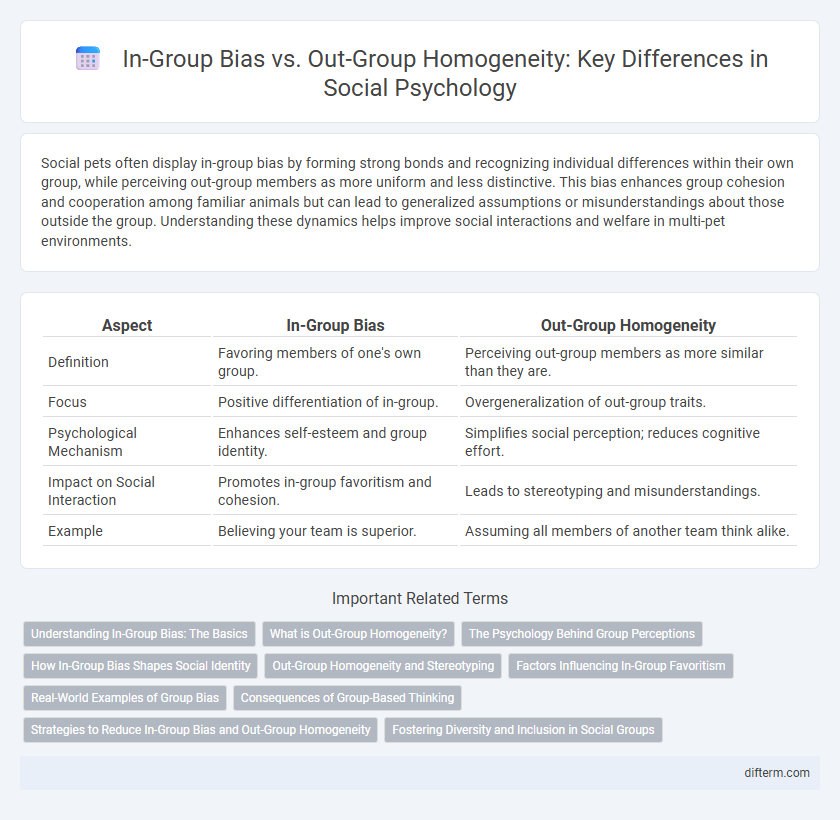Social pets often display in-group bias by forming strong bonds and recognizing individual differences within their own group, while perceiving out-group members as more uniform and less distinctive. This bias enhances group cohesion and cooperation among familiar animals but can lead to generalized assumptions or misunderstandings about those outside the group. Understanding these dynamics helps improve social interactions and welfare in multi-pet environments.
Table of Comparison
| Aspect | In-Group Bias | Out-Group Homogeneity |
|---|---|---|
| Definition | Favoring members of one's own group. | Perceiving out-group members as more similar than they are. |
| Focus | Positive differentiation of in-group. | Overgeneralization of out-group traits. |
| Psychological Mechanism | Enhances self-esteem and group identity. | Simplifies social perception; reduces cognitive effort. |
| Impact on Social Interaction | Promotes in-group favoritism and cohesion. | Leads to stereotyping and misunderstandings. |
| Example | Believing your team is superior. | Assuming all members of another team think alike. |
Understanding In-Group Bias: The Basics
In-group bias refers to the tendency for individuals to favor members of their own group over those in out-groups, often leading to preferential treatment and positive evaluations. This bias enhances social identity and group cohesion but can result in unfair judgments and discrimination against out-group members. Understanding the psychological mechanisms behind in-group bias is essential for addressing intergroup conflict and promoting social harmony.
What is Out-Group Homogeneity?
Out-group homogeneity refers to the cognitive bias where individuals perceive members of an external group as more similar to each other than they actually are, often overlooking individual differences. This phenomenon contrasts with the perception of in-group members, who are seen as diverse and unique. Research in social psychology indicates that out-group homogeneity contributes to stereotyping and reinforces social divisions.
The Psychology Behind Group Perceptions
In-group bias manifests as preferential treatment and positive evaluations of one's own group, driven by the need for self-esteem and social identity affirmation. Out-group homogeneity effect occurs when individuals perceive members of an out-group as more similar to each other than members of their own group, reinforcing stereotypes and reducing nuanced understanding. These psychological mechanisms shape social cognition by influencing how people categorize and evaluate social groups, often perpetuating intergroup conflict and social discrimination.
How In-Group Bias Shapes Social Identity
In-group bias strengthens social identity by promoting favoritism and loyalty towards members of one's own group, reinforcing a sense of belonging and self-esteem. This bias exaggerates positive attributes within the in-group while downplaying differences, which solidifies group cohesion and distinctiveness. The psychological need for acceptance and validation drives individuals to align closely with their in-group, intensifying social bonds and identity formation.
Out-Group Homogeneity and Stereotyping
Out-group homogeneity refers to the perception that members of an external group are more similar to each other than members of one's own group, leading to oversimplified and generalized views. This cognitive bias fuels stereotyping, as individuals attribute uniform characteristics to out-group members, ignoring individual differences. Stereotyping reinforces social divisions by creating fixed, often negative, assumptions that hinder intergroup understanding and cooperation.
Factors Influencing In-Group Favoritism
In-group favoritism is strongly influenced by factors such as social identity, group cohesion, and perceived competition with out-groups. The need for positive self-esteem drives individuals to favor their own group, enhancing solidarity and cooperation among members. Cultural norms and situational cues also modulate the degree of bias, shaping how individuals perceive and interact with both in-group and out-group members.
Real-World Examples of Group Bias
In-group bias often manifests in workplace teams where employees favor colleagues who share similar backgrounds or interests, leading to preferential treatment and resource allocation. Out-group homogeneity is evident in political partisanship, where individuals perceive opposing party members as more alike and less diverse in their opinions than the varied views within their own group. Sports rivalries also highlight these biases, with fans attributing greater complexity and virtue to their team while stereotyping opposing fans as uniformly hostile or less knowledgeable.
Consequences of Group-Based Thinking
Group-based thinking often leads to in-group bias, where individuals favor members of their own group, resulting in preferential treatment and reinforced social cohesion within the group. This bias intensifies out-group homogeneity, causing members to perceive outsiders as more similar and less individualistic than they truly are, which fosters stereotypes and prejudice. The combination of in-group favoritism and out-group stereotyping can escalate social divisions, increase discrimination, and hinder cross-group collaboration and understanding.
Strategies to Reduce In-Group Bias and Out-Group Homogeneity
Implementing intergroup contact strategies effectively reduces in-group bias by promoting empathy and understanding among diverse groups. Encouraging perspective-taking and fostering cooperative goals diminish out-group homogeneity perceptions, promoting accurate recognition of individual differences. Structured diversity training combined with inclusive communication enhances social cohesion and mitigates stereotyping within communities.
Fostering Diversity and Inclusion in Social Groups
In-group bias often leads individuals to favor members of their own social group, while out-group homogeneity causes them to perceive outsiders as more similar and less diverse. Fostering diversity and inclusion requires actively challenging these cognitive biases through structured intergroup contact, cultural competency training, and inclusive leadership practices. Promoting empathy and understanding across social boundaries enhances collaboration and reduces prejudice, creating more cohesive and equitable communities.
in-group bias vs out-group homogeneity Infographic

 difterm.com
difterm.com